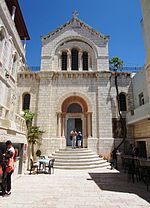June 2017 Jerusalem attack
On 16 June 2017, two Palestinian men opened fire on Israeli police officers in the Old City of Jerusalem, injuring four of them. An additional attacker stabbed a policewoman, she was critically injured, and later died in hospital. All three attackers were shot and killed by the Israeli authorities.The Islamic State of Iraq and the Levant has claimed responsibility for the attacks, but Palestinian militant organisations PFLP and Hamas rejected the claim, saying that the perpetrators were members of their groups. On 17 June, Israeli authorities said that the attack was under investigation and that there is no evidence yet for ISIL involvement.The attack was the third major terrorist attack in Jerusalem in 2017 after the 2017 Jerusalem Light Rail stabbing in which British tourist was stabbed to death, and the 2017 Jerusalem truck attack in which four Israeli soldiers were killed and 17 others wounded.
Excerpt from the Wikipedia article June 2017 Jerusalem attack (License: CC BY-SA 3.0, Authors).June 2017 Jerusalem attack
Heil HaHandasa, Jerusalem Morasha
Geographical coordinates (GPS) Address Nearby Places Show on map
Geographical coordinates (GPS)
| Latitude | Longitude |
|---|---|
| N 31.781666666667 ° | E 35.230555555556 ° |
Address
העיר העתיקה
Heil HaHandasa
9511208 Jerusalem, Morasha
Jerusalem District, Israel
Open on Google Maps










